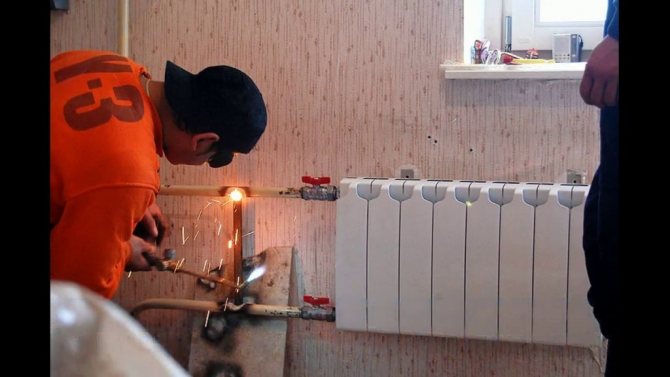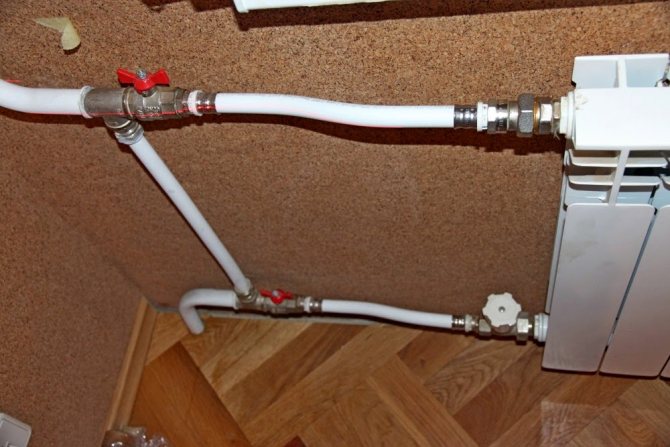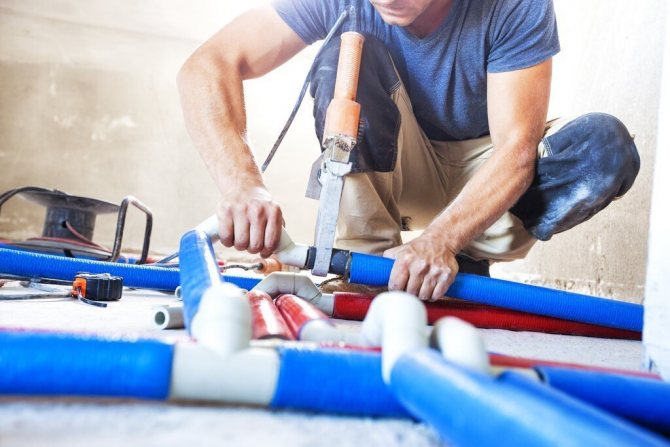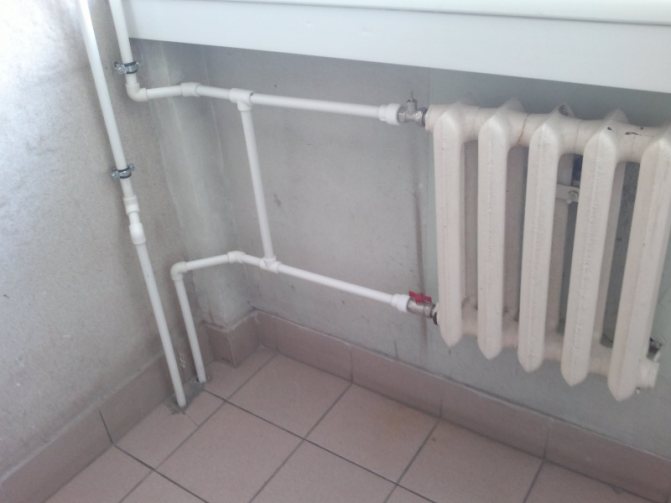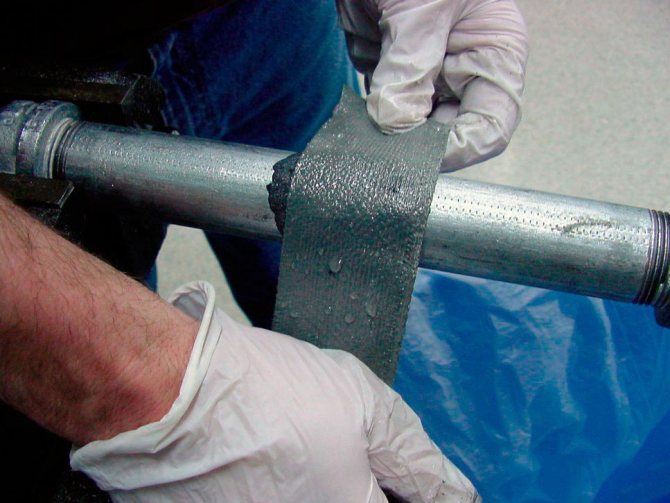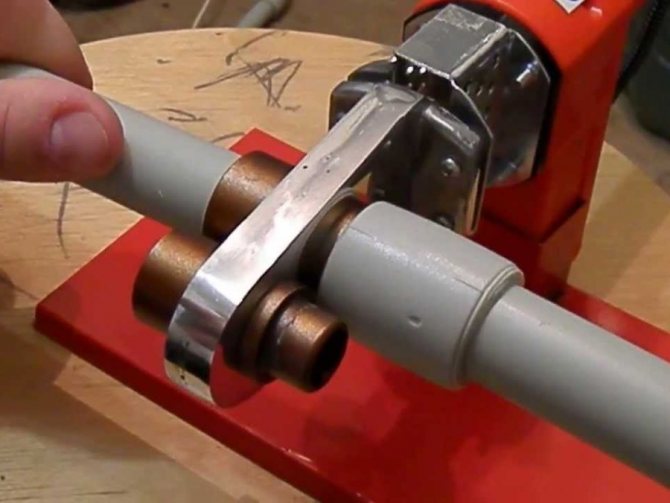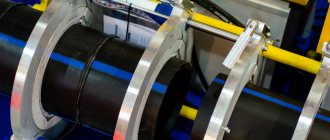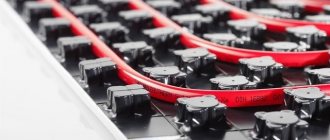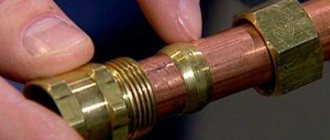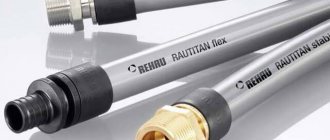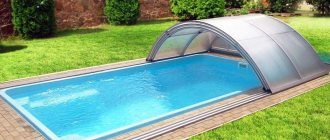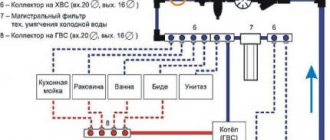Advantages and disadvantages of plastic pipes
Polymer products have a lot of advantages, among which it is worth highlighting:
- Long service life (modern plastic pipes can sometimes last for about 100 years);
- Light weight of the material;
- Complete resistance to corrosion;
- Ease of installation;
- Good strength indicators;
- Decent level of sound insulation;
- High elasticity;
- Environmental safety (plastic pipes do not change the chemical composition of the transported water);
- Low degree of thermal conductivity;
- Versatility;
- Ease of transportation;
- Low cost.
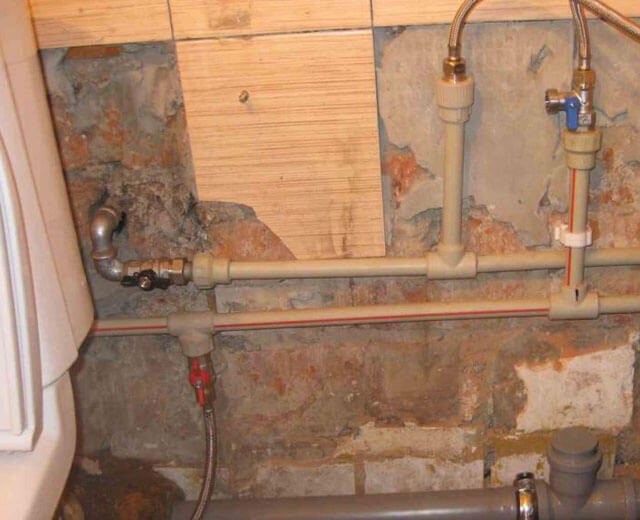
The list of advantages looks impressive. The described qualities have provided plastic pipes with recognition and the title of one of the best materials for arranging any pipelines - it is not just that old pipes are replaced with plastic ones in most houses and apartments.
Of course, plastic pipes also have disadvantages, but their list looks much more modest than the list of advantages:
- Polymer pipes have restrictions on the temperature of the transported substances (specific values depend on the material);
- Variety of installation technologies (different technologies are used to install different types of plastic pipes);
- Exposure to certain types of alkalis and acids (when choosing pipes for transporting corrosive substances, you have to carefully study their characteristics).
Material selection
Everyone has the right to decide which material suits him best, we will only take the liberty of talking about the advantages and disadvantages of the most common materials.
Steel wiring
It so happened that the price of steel is almost the most democratic. Many point to the susceptibility of the material to corrosion, but if an HMS is embedded in the system, such a wiring will stand for more than a dozen years and nothing will happen to it.
But do not rush to go straight to the market for steel pipes, there are also serious pitfalls here.
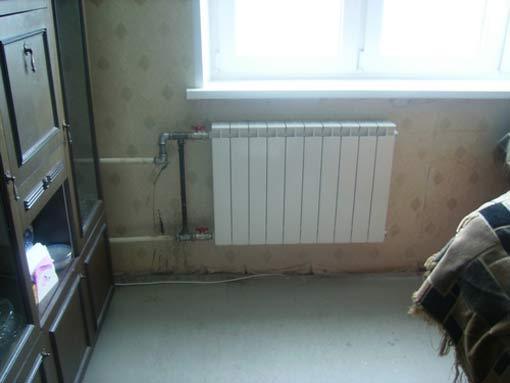

Connecting steel structures.
- The most significant disadvantage is the complexity of installation., on which we are trying to save. To weld such a pipe layout with your own hands, an unprepared person simply cannot. In addition to the welding machine itself, it is necessary to have serious professional skills that cannot be quickly mastered. Plus you will need a pipe bender and a set of dies for self-threading.
- Aluminum batteries may be the next obstacleso common in modern homes. There is nothing reprehensible in the radiators themselves, but in combination with steel they form a galvanic pair, which will invariably lead to the formation of electrocorrosion. To avoid this, you will need to cut a plastic insert with a length of at least 100 mm into the system.


Installation of wiring into the wall.
- To all this, you can add the impressive weight of the entire structure, which will require the installation of additional fasteners.... Hanging such a layout on drywall will not work.
Polypropylene wiring
- Polypropylene is referred to as PPR in documents. If we compare this modern material with traditional steel, then the metal wins only in price and strength. All other characteristics of such a wiring significantly exceed the characteristics of metal systems.
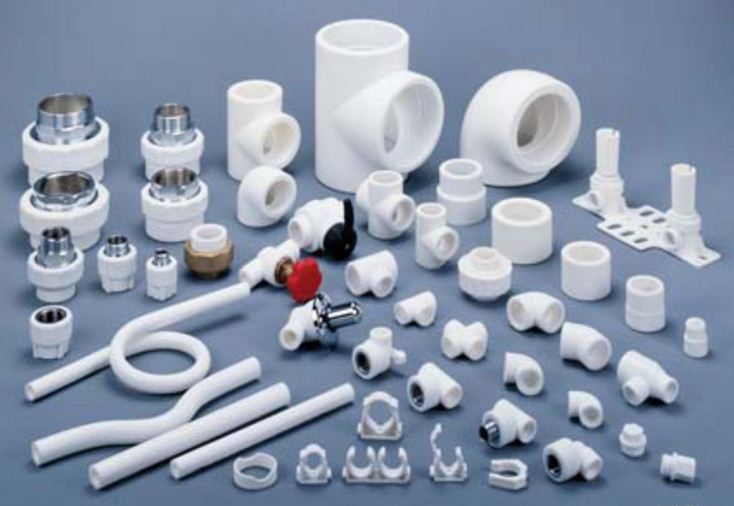

Fittings for polypropylene structures.
- For residents of multi-apartment high-rise buildings, an urgent problem is the rapid propagation of a sound wave through heating systems. A blow on a radiator or pipe, in any apartment, will be heard far beyond its borders.Polypropylene is the ideal material here, it completely dampens any sound vibrations.
- Not the least role is played by the characteristics of the thermal insulation of the wiring, as it is known in this segment the greatest heat losses are observed. Considering the fact that the price for heating, unfortunately, only increases, polypropylene can save significant amounts in the long term.
- For amateurs, do-it-yourself installation of such a system is the most acceptable option, but we will return to this issue a little later.


Polypropylene wiring.
Important: not every polypropylene pipe is suitable for heating wiring. Structures must be designed for increased pressure and temperature. We will not go into complicated calculations, we will only say that a pipe marked PN-25 is suitable for apartment buildings.
Other types of plastic and metal-plastic
- In an effort to save money, many are trying to mount alternative types of plastic, in particular, modified polyethylene is now widely advertised in PER documents. In this case, few advertisements will say that the softening temperature of this material starts from 60 ° C, versus 130 ° C for polypropylene.
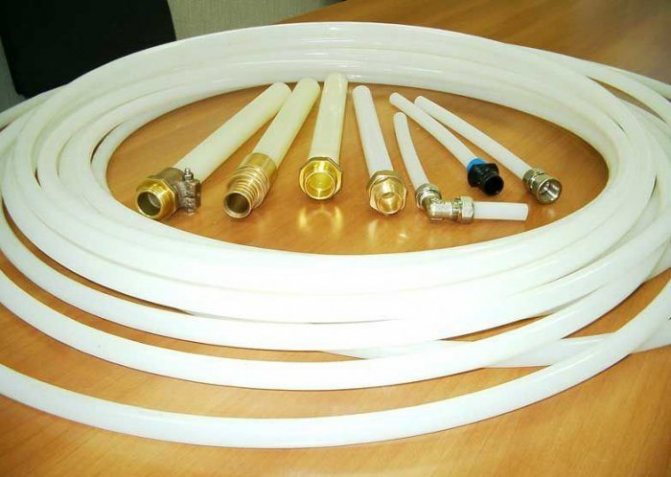

Modified polyethylene.
- Such a layout is only suitable for the southern regions of our great homeland, where the heating intensity is not so high. In the middle lane, this system will last no more than 10 years. As for the northern regions, the modified polyethylene there may not survive until the end of the heating season.
- There is also a nuance, if our Chinese friends have learned to make polypropylene of sufficient quality, then the quality of Chinese modified polyethylene leaves much to be desired. Plus, metal fittings in such a system often leak, the increased slipperiness of polyethylene affects.
Advice: the letter R indicated in the marking means the presence of a special reinforcement for the flow of a hot heat carrier. But do not forget that hot water pipes are not suitable for heating. Often it is this mistake that leads to complaints.


The structure of a metal-plastic pipe.
- The metal-plastic material is good, but it is more suitable for laying underfloor heating. Installation instructions are somewhat more complicated here, in particular, more specialized tools will be required. The walls of such pipes are quite thin and there is no need to talk about serious thermal insulation. For the same reason, such a wiring is afraid of mechanical damage, it is easy to bend it. In addition, metal-plastic is afraid of direct sunlight.
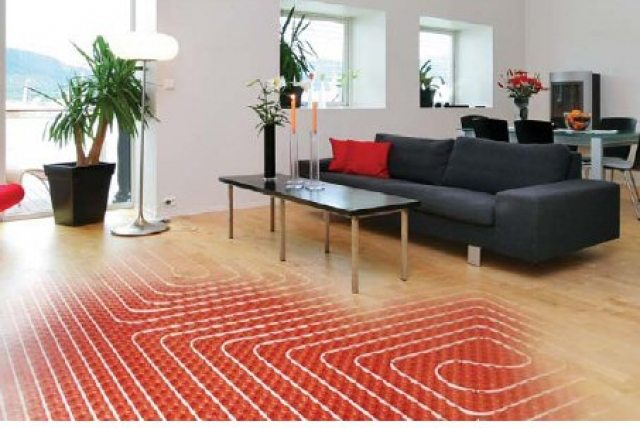

Metal-plastic wiring underfloor heating.
Copper wiring
Copper wiring.
- It's no secret that in Europe, most of the layout of old houses was made of copper. But companies selling this product on the domestic market forget to mention that this wiring is suitable for a water supply system. Heating from copper pipes is an unreliable design, it is enough to visit the relevant forums, which have a lot of angry responses.
- Let's start with the fact that the price of such a layout is far from democratic, but this is not the most important thing in this case. Copper is an excellent heat conductor, which causes high heat losses during transportation between floors.
- A modern coolant is not just water, it contains a lot of various accompanying additives that are capable of reacting with copper and corroding it.
- But the most unpleasant thing is that the soldering of such structures is often done with tin. Tin material is not durable and can crack at temperature extremes. As a result, such connections leak over time at the most inopportune moment.
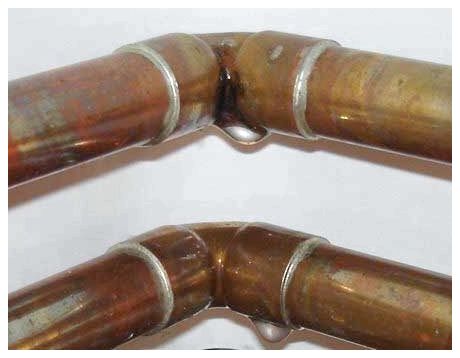

Leaky copper solder.
Important: in fairness, we note that there is also soldering of copper pipes with solders with a high silver content.Such joints are much more reliable, but solder is expensive, plus not every craftsman can work with them.
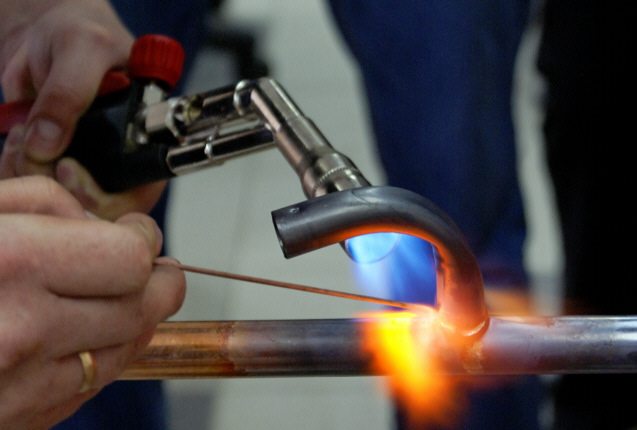

Soldering a copper connection.
Classification of plastic pipes
There are several polymer-based materials. The final products differ in their composition and production technology, therefore, before purchasing, it is necessary to study them in order to find the best option.
The following types of plastic pipes are found on the market:
- Metal-plastic (MP)... This material is made, as the name suggests, from metal and plastic. This combination withstands the effects of both low and high temperatures well - certain types of reinforced-plastic pipes can operate at a carrier temperature of 900 degrees. The main disadvantage of this material is its weak flexibility, so bending the pipes must be very careful.
- Polyethylene (PE)... Polyethylene pipes can be installed even at low temperatures, so they are often used for urgent repairs. When choosing PE pipes, you need to pay attention to the fact that it can be designed to work in conditions of either low or high pressure.
- Cross-linked polyethylene (PES)... This material is made under pressure using various additives, and the method of its production is called "stitching" - hence the name. Cross-linked polyethylene can be used both in the water supply system and in heating systems - the characteristics allow the pipes to work at a sufficiently high temperature.
- Polyvinyl chloride (PVC)... One of the components used for the production of PVC pipes is chloride, the effect of which on the human body can in no way be called positive. PVC pipes are not used when laying household pipelines.
- Polypropylene (PP)... Polypropylene pipes are the best material for laying water supply systems. The multilayer construction provides such pipes with good strength and the ability to work at high temperatures. Of the minuses, it is worth noting very poor elasticity and the lack of the possibility of painless replacement of individual elements - the connection of polypropylene pipes is carried out by welding, so the damaged areas will have to be cut out completely.
When to change pipes
The most common reason for replacing pipes is the poor corrosion resistance of cast iron and steel. They wear out over time, leading to leaks. Over the years of operation, a layer of deposits accumulates on the inner surface of the pipes, which reduces the efficiency of the entire system, since a smaller amount of coolant enters it. When the radiators become clogged with rust, they stop heating, although the riser remains hot.
The replacement is carried out when, due to an error in the project, the heating of the room is connected through the "return", so it is cold there. The impossibility of venting air from the pipes leads to cooling of the radiators and noise in the riser. In the old heating systems, it was not provided for the installation of taps to shut off pipes in each room. Therefore, in emergency cases, it is necessary to turn off the heating riser of the whole entrance.


Replacing pipes with plastic - how to change yourself
The first step is to figure out how to replace metal pipes with plastic ones. This process is not very complicated, but the work must be approached with all responsibility - even the best material cannot compensate for the incorrect assembly of the pipeline.
Before replacing, it is necessary to draw up a work plan, which, in general terms, looks like this:
- First, you need to draw a plan, which will display all the actions;
- Next, the required amount of materials is calculated (if the plan was drawn up on a scale, then you can use it);
- According to the calculations, materials, connecting elements and tools for working with them are purchased;
- Immediately before the start of work, the water is shut off;
- The old section of the pipeline is being dismantled;
- Plastic pipes are installed in the vacated space;
- After assembly, the system must be checked for operability;
- The last step is cleaning up construction waste.
Knowledge of how the pipes in the apartment are changed, and the presence of a detailed plan will allow all the work to be carried out consistently and carefully.
Replacement of water supply and heating system pipes with polypropylene
The installation of a new pipeline based on PP pipes can be performed with minimal experience and a simple arsenal of tools.
First, you need to draw up a diagram of a new engineering system, mark the sections where new pipes will run. You can navigate old pipes by measuring their length and drawing a wiring diagram on paper.
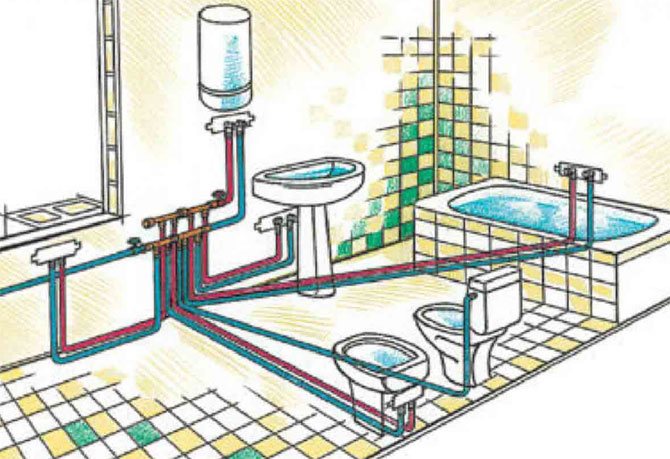

Before starting work, you should prepare the necessary equipment and materials, paying particular attention to the type of pipes that will be used.
Tools required for work:
- grinder for cutting old metal pipes;
- special wrenches for twisting threaded connections;
- soldering machine for PP-pipes ("iron").
Depending on the engineering system to be modernized, you need to buy the appropriate types of pipes. They differ in diameter and wall thickness, presence / absence of a reinforcing layer, nominal temperature and pressure in the system.
Note! These parameters can be clarified in the housing office or the management company (for an apartment building), or see the project of the engineering system (for a private house).
For the installation of heating systems, pipes reinforced with aluminum or fiberglass with a diameter of 20, 25 and 32 mm are used.The greater the length of the pipeline, the larger the cross-section of the pipe should be.
We recommend that you familiarize yourself with: How to choose and install an expansion joint for greater reliability of systems made of polypropylene pipes
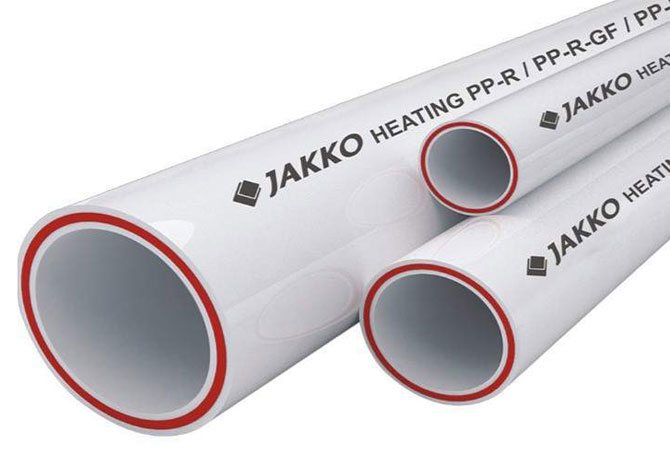

You can choose the right pipe by examining the markings on polypropylene products. It indicates the type of material, diameter and wall thickness, the class of the pipe for the nominal temperature and the maximum allowable working pressure.
In addition to pipes, you need to buy the required number of couplings - fittings, as well as materials for sealing joints (fumlent, oil seals, rubber seals - depending on the type of system).
It is necessary to note the places of installation of new radiators (usually old cast-iron batteries are replaced with new aluminum or bimetallic ones).
To connect pipes and fittings made of polypropylene, a special soldering machine is used for welding pipes by means of heating.
Do not forget about tools for cutting pipes - special scissors, as well as liquid for degreasing pipes before brazing.
Important! Before starting work, you must make sure that the water in the system is shut off. In apartment buildings, any pipe replacement work affects communications in the neighbors' apartments on the upper and lower floors. It is advisable to warn them about temporary inconveniences, or notify the housing office of the need to shut off the water in the riser.
Dismantling old pipes
After draining the water from the system, you can start dismantling the old elements of the system - plumbing products (if necessary), heating radiators.


The water is drained from the battery through a special valve. As a rule, an old cast-iron battery cannot be repaired anymore; it must be thrown away and replaced with a new type of radiator - bimetallic, steel or aluminum. After dismantling the battery, the old metal pipes are cut off with a grinder 3-5 cm from the ceiling and floor. Having cut off the pipe, you need to put adapters in its place.
Preparation for the installation of PP pipes
Pre-purchased polypropylene pipes must be cut in accordance with the pipeline installation diagram.You need to do this with special scissors (sold in hardware stores).
Attention! When replacing pipes in heating systems with polypropylene pipes, it is imperative to take into account the thermal expansion. When heated, such pipes tend to increase in length by 1.5-1.7 cm. This figure must be added to the estimated length of the pipeline, and also take care of the movable fixation of the pipes along the walls.
Fittings for polypropylene and metal pipe connections
To connect the pipes to each other, special transition elements are used - fittings. They are polypropylene products, as well as polypropylene combined models with a metal insert.
We recommend that you familiarize yourself with: Piping diagrams and options for installing a heating system in a private house with your own hands
Fittings with internal metal thread are used to connect PP pipes with metal elements - pipes, adapters, ball valves.
Several main types of fittings are used to replace engineering systems:
- coupling - used to connect in a straight section, as well as to connect two pipes of different diameters;
- angular (elbows) - needed to connect pipes at right angles for installation in places where the pipeline turns;
- tees - fittings for wiring (for example, to create a branch for entering a hose from a washing machine to a sewer).


For PP pipes, it is necessary to use special fasteners - plastic brackets, which are screwed to the wall with self-tapping screws. Their diameter must match the diameter of the pipes.
Attention! In pipe sections near the wall or in the corner of the room, it is necessary to use special movable fasteners that ensure free movement of the pipes during linear expansion. Leave a gap near walls and especially in corners.
Dismantling old pipes
Disassembling an old pipeline is a process that needs to be approached individually. Some elements of the system may be able to be dismantled with a screwdriver or an adjustable wrench, while in other situations a grinder will be required.
The general set of tools required for dismantling is reduced to the following list:
- A hammer;
- Bulgarian;
- Perforator;
- Chisel;
- Scrap;
- Grinding discs;
- Screwdriver Set;
- Knife;
- A pair of adjustable wrenches.


It will be ideal if the replacement of pipes with plastic is carried out along with the repair of housing - firstly, you do not have to clean up the garbage twice, and secondly, during the repair it is much easier to hide communications in the walls, if such a desire arose.
Replacing plumbing pipes
Before starting the installation of PP-pipes, it is necessary to mark them for cutting and soldering with fittings in accordance with the length of the pipeline section in the diagram.
When marking, it is necessary to provide for the installation locations of new heating radiators, as well as the points of entry for the hoses of the washing / dishwasher, connecting the tank, washbasin, sink, bathtub, shower, main filters and other system elements. The batteries can be put in place of the old ones, or you can choose another place for them.


Before starting work, you need to take care of special mounts for the battery - brackets.
When the new polypropylene pipes are cut in accordance with the pipeline diagram, you can start welding.
- The soldering machine for PP pipes heats up to 260 ° C together with Teflon nozzles, the diameter of which corresponds to the diameter of the pipe and coupling.
- The end of the pipe and fitting is pre-cleaned and degreased.
- The fitting and the end of the pipe are simultaneously placed on the Teflon nozzles and heated up for 5-7 seconds.
- Both elements of the pipeline are removed from the soldering iron and immediately connected to each other with an accurate and accurate movement.The elements to be connected must be pressed tightly for 10-25 seconds in order to form a strong sealed connection. A ring of displaced polypropylene layer should form at the point where the pipe and fitting meet. During the connection of the elements, they must not be turned, otherwise the tightness will be broken.
We recommend that you familiarize yourself with: What heating is better and how to mount it in a private house
Installation of plastic pipes
After dismantling the old parts of the pipeline, events can develop according to two scenarios:
- Plastic parts will be installed in place of the removed elements;
- The entire pipeline will be re-laid.
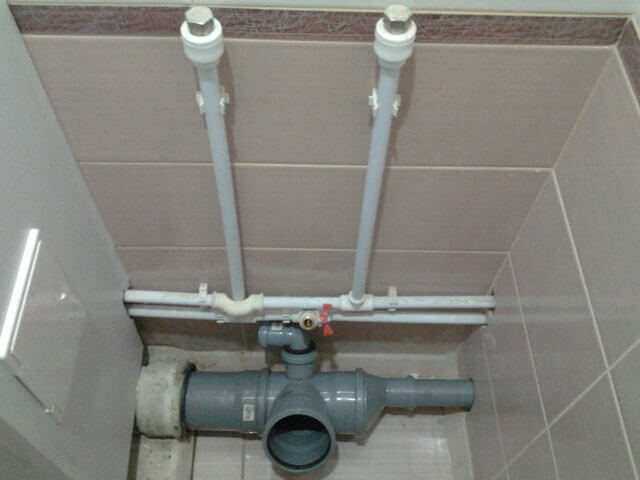

In any case, no matter what scenario is chosen, the pipes will still have to be connected, and for this it is necessary to select the appropriate technology. In most cases, plastic pipes are connected with a special welding machine or installed using fittings.
Conclusion
Replacing plastic pipes with your own hands is quite possible and not particularly difficult. First, you need to draw up a detailed plan of action - and half of the work can already be considered completed. The implementation of the plan will be the second part of the work, and after its successful completion, all that will remain is to rejoice at the updated pipeline.
Metal-polymer pipes
Having appeared on the construction market in the early 80s, metal-polymer pipes immediately began to be actively used in heating systems, internal cold and hot water supply. Since then, the technologies for the production of such pipes have significantly improved, which was determined by the following reasons: an increase in the market share of plastic systems; an increased need for innovation to increase sales; the ability to block the penetration of oxygen into plastic heating systems.
The main advantage of multilayer metal-plastic pipes in heating and water supply systems is the combination of the advantages of plastic and metal pipes into one combined material that has good corrosion resistance and flexibility, combined with sufficient tensile strength.
